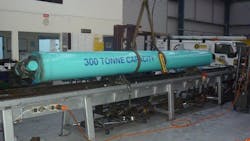Troubleshooting Challenge: Cylinder Load Testing Problems for a Crane
I was teaching at a customer when they told me about a large double-acting 10-in. bore crane cylinder, 16 ft long that was giving them problems. Twice a year they would run a test by lifting a large concrete block 12 in. off the ground and check to see if it drifted down more than ½ in. in two hours. The cylinder was extended about halfway out for the test.
The cylinder failed the test and they had the authorized dealer exchange it for a rebuilt unit.
They set the test up again on the new cylinder lifting the load 12 in.
When they went to check the results, they could not believe their eyes. The load was higher than the original 12-in. height. They set the test up again and now it failed. They wondered if the change in the weather had anything to do with it. It was raining when they set up the first test and sunny when they checked it. They set up the second test in the sun and it was raining when they went to check it.
Be sure to check out next month’s installment of “Troubleshooting Challenge” for the solution to this problem.
Solution to Last Month's Problem:
Hose Keeps Failing on a Large 100-Ton Press
A 100-ton press was designed and installed to close and form large pieces of ¼- to ½-in. thick metal. To extend the press, solenoids 1B, 2A, and 3B would energize extending the ram engaging the metal. The decompression valve 3B and solenoid 2A would de-energize. When the pressure transducer dropped below 2,000 psi, solenoid 2B would energize and retract the ram.
The flow control was only used to create enough backpressure to keep the pilot-operated check valve open while the ram extended. The pressure-compensated pump had a volume stroke adjustment to control the ram speed that they would need from time to time.
A problem with the rod-end hose blowing off started when the speed of the ram was reduced so they could process thinner plates. They would run several hundred plates and the hose would fail.
What was causing the problem?
When the set-up man adjusted the press to run at a lower speed, he adjusted the flow control valve that was used for backpressure. He should have adjusted the pump flow control adjustment as the instruction manual illustrated.
The cylinder has a 2.78:1 area ratio, which would cause the rod pressure to intensify to about 7,800 psi every time it extended, but the 2 in. hose was only rated for 3,000 psi.
About the Author

Leaders relevant to this article:
